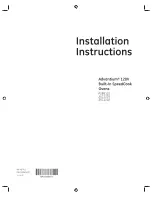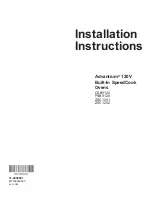
B.
If the blower motor does not come on,
proceed to step 3.
3.
Check for +5 VDC on the input side of SSR
(terminals 3 & 4).
A.
If +5 VDC is present, continue to step 4.
B.
If no voltage is present, computer control is
not functioning properly.
4.
Check for proper input voltage on the load side
of SSR terminal 1 and the power connection on
the other side of the supply.
A.
On 208 & 240 volt ovens, the supply
connection is on the terminal block (L2 for
single phase, L3 for three phase). The
measured voltage should be identical to the
supply.
B.
On 480 volt ovens, the supply connection is
on the secondary side of the 480V
transformer, terminal X4 (wire # 79).
The measured voltage should be 240 volts.
5.
If input voltage is correct on the load side of SSR
terminal 1, proceed to step 6.
A.
If input voltage is
not
correct, find the source
of the problem.
6.
Check output voltage on the load side of SSR
terminal 2.
A.
If voltage is correct, SSR is functioning
properly.
B.
If no voltage is present on the load side of
SSR terminal 2, the SSR is
not
functioning
properly.
7.
Turn the power switch OFF.
Disconnect the
electrical power to the machine and
follow lockout / tagout procedures.
There may be multiple circuits. Be sure
all circuits are disconnected.
8.
Replace the SSR and check for proper operation.
COMPUTER CONTROL
TEMPERATURE CALIBRATION
1.
Place a thermocouple in the geometric center of
the oven cavity.
2.
Turn the power switch ON.
A.
If the set point temperature is 350°F,
proceed to step 4.
B.
If the set point temperature is other than
350°F, proceed to step 3 to change the
temperature.
3.
Press the set key then temperature key to enter
the temperature set mode.
A.
The display will alternate between the term
"StPt" (set point) and the current oven
temperature setting.
B.
Press the up or down arrow keys to make
the proper selection.
C.
Press the set key again to save the change
and exit the temperature set mode.
4.
Allow the oven temperature to stabilize (normally
3 cycles).
5.
Compare the controls set point temperature to
the thermocouple meter reading when the heat
light goes out.
A.
A temperature variance
more
than 5°F
indicates an adjustment is needed.
1)
To make the adjustment, proceed to
step 6.
2)
If temperature variance is
less
than
5°F, computer control is functioning
properly.
6.
Enter the setup mode as outlined in SETUP
MODE under COMPUTER CONTROL.
A.
Advance through the menu until CAL1
(Calibration Offset) appears.
1)
If the thermocouple reading is higher
than set point temperature, press the
down arrow key and enter a
negative
offset value that is equal to the number
of degrees above the 5°F tolerance.
2)
If the thermocouple reading is lower
than set point temperature, press the
up arrow key and enter a
positive
offset value that is equal to the number
of degrees below the 5°F tolerance.
3)
Exit the setup mode.
7.
Allow the oven to cycle at least two times
between adjustments.
A.
If the temperature variance still differs more
than 5°F from the set point, verify the correct
calibration offset value was entered and
retained.
1)
) Adjust the calibration offset value as
outlined in step 6, until the cycling
temperature is within tolerance.
VC4E & VC6E Series Full Size Electric Convection Ovens - SERVICE PROCEDURES AND ADJUSTMENTS
Page 31 of 64
F25105 Rev. B (0217)
















































